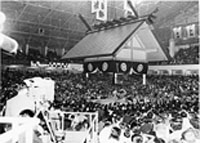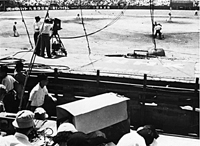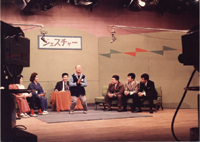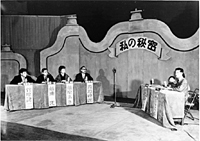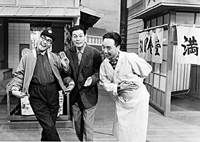|
Popular sumo broadcasts on
TV
|
Baseball relays: pro and amateur
games
|
Reserved seats at home
TV made it possible for ordinary people
to enjoy stage performances, concerts and sports events that used to
be available only to the privileged few who could buy tickets. In effect,
it provided special reserved seats for everyone, bringing these forms
of entertainment right into the living room. Over the course of the
next few years, programs made especially for television showed a rapid
growth in popularity.
New program formats
Successful new made-for-TV program formats
included Gesture Game (from 1953),
a game show in which guests had to convey a certain theme by means of
gestures or mime. Another, starting in 1955, was Personal
Secrets, in which panelists had four minutes to identify a mystery
guest from given hints. The way the game developed as the audience watched
made for compelling viewing, and led to a climactic moment near the
end of the program when a close acquaintance of the guest was brought
in.
|
Gesture Game
|
Personal Secrets
|
The Comic Trio
|
|
|
Focus of attention
at home
As the production of TV sets rose in the
late 1950's, the price declined and they became much more affordable.
At the same time, the reach of the TV networks expanded to include all
the major cities from Sapporo in the north of Japan to Fukuoka in the
south, enabling reception throughout the country.
The resulting change to family lifestyles
was dramatic. With the TV established as the focus of attention, people's
viewing time soon increased to an average of nearly three hours per
day.
First international coverage
In 1959, when fewer than 50,000 Japanese traveled abroad each
year, NHK aired a 13-part series titled Overseas
Report: The African Continent. Material for the series
was gathered in 22 countries in Africa. The first program, Visit
to the United Arab Republic, was broadcast only 27 days
after the crew's departure from Japan—an amazing feat at
the time.
Window on the world
The success of Overseas Report
resulted in the making of further series, focusing in turn on
Southeast Asia, Latin America, and the Middle East. The programs
explored the history, culture, politics, economy, and nature of
these different regions and served as a window on the world for
the growing number of people interested in finding out about other
countries.
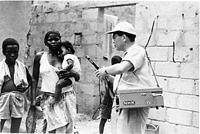
The first overseas coverage team was comprised of reporters
Toyohara Kenichi, Yamashita Akio, who was well-versed in foreign
languages, and cameraman Sano Isamu.
|
|


